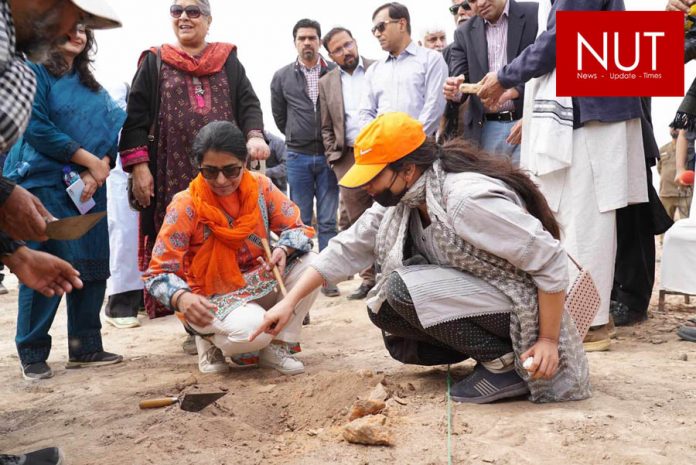Lahore (Qasim Ali)
Archaeological excavation at the site of Ganweriwala Cholistan (5000 years old Indus Valley Civilization – in the midst of the Cholistan desert on the river Hakra) is going on briskly from last one weekw with active participationof young and professionals alike. At the historical site, the excavations work commenced on 1st march by commissioner Bahawalpur division Dr. Ehtasham Anwar and DG archaeology Punjab Shozeb Saeed and THAAP is honored to be the implementing partner of excavation work at historic project of Ganweriwala Dig. Led by Chief archaeologist Dr. Mohammad Rafique Mughal (Professor Emeritus of Archaeology Boston University) the excavation work has turned into unique learning and capacity building opportunity for the archaeology students. Young & bright students from Islamia University of Bahawalpur, Balochistan University and Punjab University are physically present at the Ganweriwala site and taking deep interest in the excavation work. After passing the whole day at the Ganweriwala site they reside in the base camp established near the site in the desert. Dr. Rafique Mughal expressed his satisfaction over the pace of excavation work. While sharing the details of ongoing work Dr. Rafique Mughal said it is amzing to see the student’s active participation in the work as Ganweriwala project includes intensive training in the field of archaeology for selected university students both male and female as part of its efforts to build capacity for the future archaeology mission. With this mission statement the students are busy and practically engaged in excavation work. The excavation team comprises on relevant professional experts including Dr. Rafique Mughal as Chief Archeologist, Saleem ul Haq (Deputy Team Leader) Muhammad Afzal Khan Sr Archaeologist, Muzzafar Ahmed, Hassan Khokar archaeologist representative from Department of Archeology Punjab and support staff includes Chemist, Draftsman, Lab Assistant, Pollery Recorder, Surveyor, Data entry operator, photographer and documentary maker too. The Key experts Prof. Sajida Haider Vandal, Prof. Pervaiz Vandal, Dr. Nasarullah Nasir Khan (Advisor ICH) are closely monitoring the excavation work. The mound of Ganweriwala in Cholistan contains one of the largest cities of the Harappan or Indus Civilization which reached its climax about 2600 BCE. It was discovered in the mid-1970s during an extensive survey and schematic mapping of ancient sites carried out by Dr. Rafique Mughal and his team from the erstwhile Federal Department of Archaeology. More than four hundred sites representing the origins, rise, climax, and decline of the Indus / Harappan Civilization were recorded situated all along the (now) dry bed and channels of the Hakra River in Cholistan. The size of settlements during the period of the Harappan Civilization and early cultures (3400 to 1900 BCE shows progressive increase until climax and then decline during the last phase of the Late Harappan period. In the Hakra – Kot Diji or Early Harappan period, the average size of the largest settlement was 27 hecters. The climax of the Harappan Civilization as represented at Mohenjo-Daro and Harappa, the largest site in Cholistan called Ganweriwala spreads , this site showed a sharp decline most probably coinciding with the decline in the water and food resources, inducing partial migration of population to the desert and opting for nomadic life. After being neglected for more than 50 years the excavation work to reveal the hidden wonder at ganweriwala is being initiated last week and will continue for upcoming several weeks. According to the team the excavation work required 3, 4 more sessions to collect the real amazing facts about the lost city of the Indus valley civilization.






